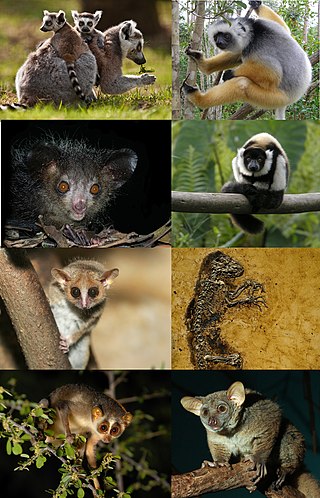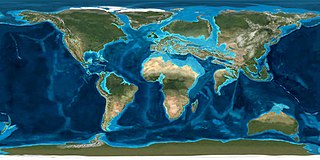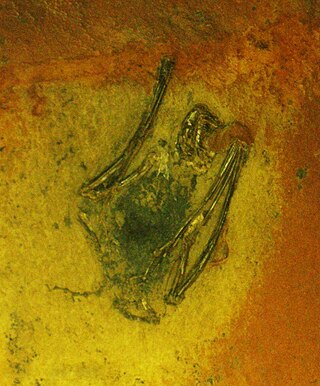
Strepsirrhini or Strepsirhini is a suborder of primates that includes the lemuriform primates, which consist of the lemurs of Madagascar, galagos ("bushbabies") and pottos from Africa, and the lorises from India and southeast Asia. Collectively they are referred to as strepsirrhines. Also belonging to the suborder are the extinct adapiform primates which thrived during the Eocene in Europe, North America, and Asia, but disappeared from most of the Northern Hemisphere as the climate cooled. Adapiforms are sometimes referred to as being "lemur-like", although the diversity of both lemurs and adapiforms does not support this comparison.

Lemuriformes is the sole extant infraorder of primate that falls under the suborder Strepsirrhini. It includes the lemurs of Madagascar, as well as the galagos and lorisids of Africa and Asia, although a popular alternative taxonomy places the lorisoids in their own infraorder, Lorisiformes.

The Messel pit is a disused quarry near the village of Messel about 35 km (22 mi) southeast of Frankfurt am Main, Germany. Bituminous shale was mined there. Because of its abundance of well-preserved fossils dating from the middle of the Eocene, it has significant geological and scientific importance. Over 1000 species of plants and animals have been found at the site. After almost becoming a landfill, strong local resistance eventually stopped these plans and the Messel Pit was declared a UNESCO World Heritage Site on 9 December 1995. Significant scientific discoveries about the early evolution of mammals and birds are still being made at the Messel Pit, and the site has increasingly become a tourist site as well.

Adapiformes is a group of early primates. Adapiforms radiated throughout much of the northern continental mass, reaching as far south as northern Africa and tropical Asia. They existed from the Eocene to the Miocene epoch. Some adapiforms resembled living lemurs.

In the geologic timescale the Ypresian is the oldest age or lowest stratigraphic stage of the Eocene. It spans the time between 56 and47.8 Ma, is preceded by the Thanetian Age and is followed by the Eocene Lutetian Age. The Ypresian is consistent with the lower Eocene.
Birbalomys is an extinct genus of rodent from Asia.

Ailuravus is a genus of prehistoric rodents in the family Ischyromyidae.

Teilhardina was an early marmoset-like primate that lived in Europe, North America and Asia during the Early Eocene epoch, about 56-47 million years ago. The paleontologist George Gaylord Simpson is credited with naming it after the French paleontologist, Jesuit and philosopher Teilhard de Chardin.
Eobarbourula delfinoi is an extinct toad which existed in what is now Gujarat, India, during the Middle Ypresian age of the early Eocene. It was described by Annelise Folie, Rajendra S. Rana, Kenneth D. Rose, Ashok Sahni, Kishor Kumar, Lachham Singh and Thierry Smith in 2012, and is the only species in the genus Eobarbourula. The name of the genus is a combination of "Eo", referring to the epoch in which the animal existed, and Barbourula, the generic name of the jungle toads, while the specific epithet refers to Massimo Delfino, an Italian paleontologist.
Indohyaenodon is an extinct genus of placental mammals from family Indohyaenodontidae within extinct order Hyaenodonta, that lived during the early Eocene in India.
The Willwood Formation is a sedimentary sequence deposited during the late Paleocene to early Eocene, or Clarkforkian, Wasatchian and Bridgerian in the NALMA classification.
Cambaytherium is an extinct genus of placental mammals in the family Cambaytheriidae whose fossils were found in an open pit coal mine located in Gujarat, India. The mine was a treasure trove full of teeth and bones, over 200 of which were identified as belonging to Cambaytherium thewissi. The fossils were dated to the Early Eocene, 54.5 million years ago, making them slightly younger than the oldest known fossils belonging to the order Perissodactyla.
Indiagama is an extinct genus of agamid lizard known from the type species Indiagama gujarata from the early Eocene of India. Indiagama was named in 2013 on the basis of a single lower jaw from the Cambay Shale in Gujarat. The rectangular shape of its teeth distinguish it from all other agamids, living and extinct.
Suratagama is an extinct genus of agamid lizard known from the type species Suratagama neeraae from the early Eocene of India. It was named in 2013 on the basis of three isolated jaw bones from the Cambay Shale in Gujarat.
Priscagamidae is an extinct family of iguanian lizards known from the Late Cretaceous of Mongolia and China and the Eocene of India, spanning a range from 75 to 54 million years ago. It includes the genera Heterodontagama, Mimeosaurus, Phrynosomimus, Priscagama, and possibly Pleurodontagama. The first fossils of priscagamids were found in the Djadochta and Khermeen Tsav formations of Mongolia. More recently they have been found in the Cambay Formation in India, leading to the naming of Heterodontagama in 2013. Priscagamidae was originally described as a subfamily of Agamidae called Priscagaminae in 1984, but it was reclassified as a distinct family in 1989. Most phylogenetic analyses still find a close relationship between Priscagamidae and Agamidae, although a 2015 study found it to be basal to all other iguanian clades, warranting its removal from Iguania and placement in a larger clade called Iguanomorpha.
Heterodontagama is an extinct genus of iguanian lizard from the Early Eocene of India. It belongs to the extinct family Priscagamidae, which is otherwise only known from the Late Cretaceous of Mongolia. The type species Heterodontagama borsukae was named in 2013 from several isolated upper and lower jaws found in an exposure of the Cambay Shale in an open-pit coal mine in Gujarat.
The Amphipithecidae were simian primates that lived in Late Eocene and Early Oligocene. Fossils have been found in Myanmar, Thailand, and Pakistan. The limited fossil evidence is consistent with, but not exclusive to, arboreal quadrupedalism. In other words, the species may have moved about in trees on four legs, but not with regular leaping as seen in later simians.
Bownomomys was an early marmoset-like primate that lived in North America during the Early Eocene epoch, about 56-50 million years ago.

Hassianycteris is an extinct genus of Early Eocene (Ypresian) bats from the Hassianycterididae with two or three known species: the type, found in the Messel pit, Germany, H. kumasi, found in the Cambay Shale Formation, India, and the possible third species "H." joeli, found in the Kortijk Clay Formation, Belgium. Alongside Palaeochiropteryx tupaiodon, P. tupaiodon and Hassianycteris kumari are the first fossil mammals whose colouration has been discovered: both were reddish-brown when alive. H. messelensis was probably a similar colour when alive.
The Cambay Shale Formation is geologic formation in India. It is also known as the Vastan Lignite mine.









